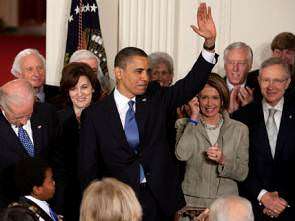Emergency Room Visits Continue to Rise Under Obamacare
The health law was supposed to reduce pressure on emergency care facilities. It hasn't.

In September, 2009, President Obama gave a prime time speech to the joint Congress making the case for the health care law that would come to be known as Obamacare. Much of the speech was devoted to explaining and justifying the law's major components. Subsidies, he argued, were necessary to ensure that health coverage would be affordable enough that people would actually buy it. The individual mandate requiring most people to maintain coverage was necessary to ensure that free-riders didn't take advantage of the law's regulations and subsidies to wait until sick before purchasing coverage.
"Such irresponsible behavior costs all the rest of us money," Obama said. "If there are affordable options and people still don't sign up for health insurance, it means we pay for these people's expensive emergency room visits."
Nearly six years later, the mandate is in force, and the subsidies are offsetting a hefty chunk of the premiums for most of the people who've gained private coverage through the law's exchanges. Millions of people have been covered by the law; last month, Gallup reported that the national uninsurance rate had dipped to its lowest point since 2008.
And yet in the time since Obamacare's major coverage expansion has kicked in, the number of emergency room visits has not gone down. Nor has it held flat. Instead, it appears to be growing, perhaps quite a bit, according to a survey of nearly 3,000 ER doctors noted in The Wall Street Journal. Granted, this is a survey, so it may not be the most precise way to guage what's happening to ER usage under Obamacare, but it certainly provides a sense of how those on the ground, working in ERs, view what's happening.
The report suggests that the increase in utilization may be quite significant. The Journal quotes one ER doctor in Lexington, Kentucky as saying that emergency room visits rose 10 percent last year (the first year in which coverage was widely expanded under the law) and has gone up 20 percent during the first few months of this year.
The idea that expanding coverage would reduce emergency room visits was always among the weakest arguments for the health care law. That certainly wasn't the experience in Massachusetts in the years following the implementation of its health care overhaul under Gov. Mitt Romney, which served as a model for the national plan. And it's been clear for years that Medicaid beneficiaries, who often have trouble finding doctors, end up in the emergency room more often than other types of patients. That seems to be a big part of the story here. Back to the Journal:
Many doctors don't accept Medicaid patients because the state-federal coverage provides lower reimbursement rates than many private health-insurance plans. The waits for primary and specialty care by participating doctors appear to be leaving some Medicaid patients with the ER as the only option, according to ACEP.
And it's not just that there are more patients—the patients are, it seems, somewhat sicker than before. As the Journal reports, "the ACEP survey also found that ERs are seeing sicker patients: About 90% of the doctors polled said the severity of illness has stayed the same or gotten worse."
The U.S. health care system's overreliance on emergency room care, which is generally more expensive than other, more regular types of health care, is one of the problems that Obamacare was supposed to solve, or at least mitigate. Instead, it looks like the law has made the problem worse; it was a fix that, predictably, only made things even more broken.


Show Comments (198)